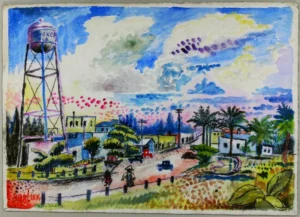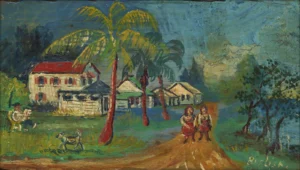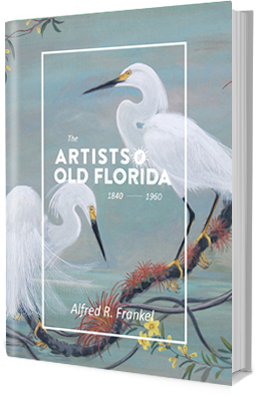David Burliuk, The Fishing Boat, oil on Masonite, 16 by 20 inches. Signed lower left, inscribed Florida, lower right.
If soul or psyche defines any artists work, surely David Burliuk’s life and work reflect one of the most colorful, complicated, and soulful of all Florida artists. Born in 1882, a Russian citizen and a descendent of Ukrainian Cossacks, by 1913 he was a poet, painter, and considered one of the founders of Russian Cubo-Futurism. Burliuk exhibited with the Blaue Reiter in Munich and was later expelled from the Russian Art Academy. After his brother was killed in World War I, and with the beginning of the Russian Revolution in 1917, Burliuk fled the country though Siberia, Japan, and Canada, finally arriving in New York City in 1922.
David Burliuk, Pahokee, Fla., watercolor on canvas, 11 by 15.5 inches. Signed lower right, Burliuk.
The Brooklyn Daily Eagle, March 9, 1924, notes his arrival. “David Burliuk, a Russian modernist painter, who founded futurism in Russia, who has been in this country for the past two years, believes in shocks and knows how to give them. He describes the shocks he gives us as esthetic and declares that what artists must do is to jar the public into recognition of what modern art and modern painters are doing. David Burliuk himself is the best shock of all those he sends out. In almost every art gallery exhibition where modern paintings are shown, in the center of a group of amazed and dazzled listeners stands David Burliuk solidly. Burliuk glistens. He gleams. And this is not scintillation from personality alone. A newcomer has just entered the exhibition room. He glances at the crowd. Then he sees Burliuk. He rubs his eyes and looks again. A man wearing one earing! Wearing an enormous earing of green glass and gold! A man wearing a waistcoat of black taffeta and roses scattered on it! Roses five inches in diameter. ‘Who is that?’ the newcomer whispers to the initiated. ‘David Burliuk, the Russian painter.’ Then the newcomer notes the man further. A square man he is, powerful as a woodsman, a figure carved out of terra cotta he seems…. Burliuk three times crossed Siberia during the War. He carried to Siberian villages literally buried in snow the news of the modern art movement in Europe.”
David Burliuk, oil on canvas, 4 1/8 by 7 1/4 inches. Signed lower right, Burliuk.
Burliuk first came to Bradenton in the winter of 1941. The Bradenton Herald, March 5, 1946, noted, “Mr. Burliuk was greatly impressed with this section of the state…and on his current stay here will paint Bradenton Beach scenes, Bradenton Street scenes….” Burliuk and his family continued to spend winters on Anna Maria Island, visiting at the Bradenton Art Center, and opening a one-man exhibit of his work there in February 1959. Later that year, when busy with a one-man exhibit in Munich, Germany, Burliuk sent a card to the Art Center with, “plans to leave soon for Paris by way of Switzerland, arriving home in December and at home on Anna Maria Island before Christmas with pictures for exhibit at the Art Center for the winter of 1960, already arrived.” That winter the Burliuk’s lent the Art Center paintings from their own collection of European and American art, along with nine paintings by Burliuk and three watercolors by son Nicholas.
David Burliuk, The Fishing Station, oil on canvas, 20 by 30 inches. Signed lower right, titled verso, on old ACA Gallery label.
In 1961 at the American Contemporary Art Gallery on East 57th Street in New York City, Burliuk had the distinction of his entire collection of 70 paintings being sold before the exhibit opened. When Burliuk died in 1967 the Russian born artist was the last living member of Germany’s Blue Rider modernist art movement. In Russian poetry, Burliuk is regarded as a trailblazer. In 1990 the Russian Academy of Futurist Poetry established the David Burliuk Prize for experimental poetry awarded annually. Burliuk’s paintings are in the collections of leading American museums including the Metropolitan Museum, the Whitney Museum of American Art, New York City, Phillips Museum, Washington, D.C., the Boston Museum and Yale University.
Born: 1882, Russia. Died: January 15, 1967, Hampton Bays, New York. Education: Royal Academy, Munich; Kazan and Odessa art schools; Moscow School of Painting, Sculpture and Architecture; in Paris with Cormon, teacher of Toulouse-Lautrec and Matisse; In Munich. Membership: Munich’s Blaue Reiter; Anna Marie Island Art Association; Art League of Manatee County. Exhibits: Pensacola Federal Art Galleries, American Artists, December 1937; Miami Federal Art Galleries, American Artists, January 1938; Society of the Four Arts, American Artists Today, January-February 1942; Society of the Four Arts, Watercolor Exhibit, December 1944; Anna Marie Island Art Association, 4th Annual, Community Hall, February 14-15, 1953; Anna Marie Island Art Association, March 1955; Manatee County Art League, Bradenton Art Center, February 1959, one man exhibit; Anna Maria Island Community Hall, sponsored by Woman’s Auxiliary of the Church of the Annunciation, Sunday March 8, 1959, two oils, Floral Bouquet on Gulf of Mexico and Homestead in Manatee; Maitland Art Center.







